Bonfire of the Inanities
by Jacqui Shine
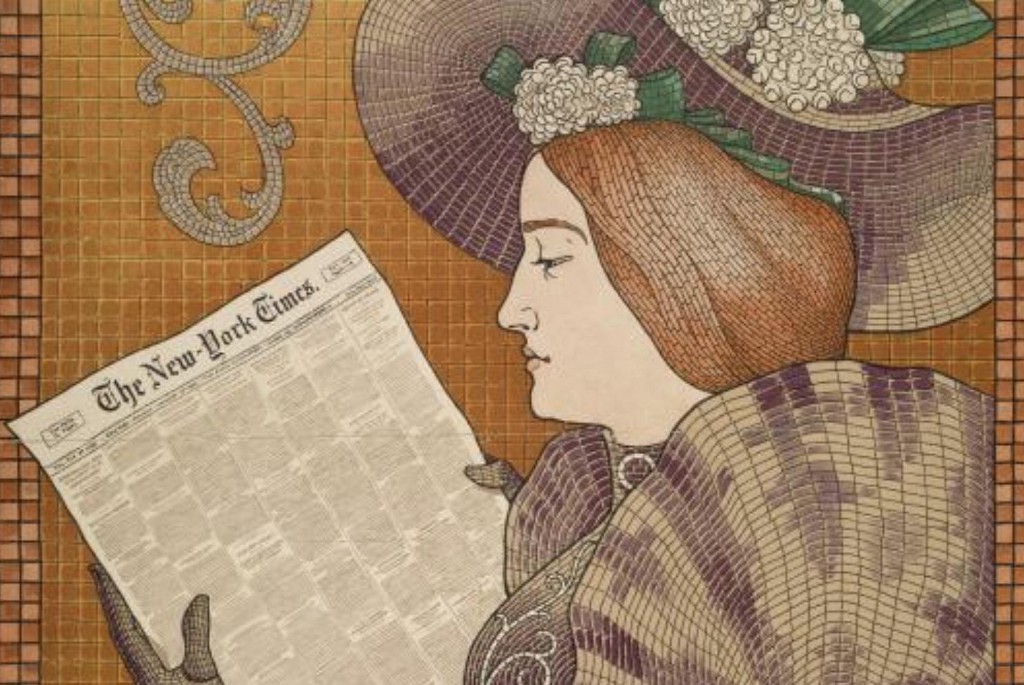
Courtesy NYPL
The story arrived in November of 1992 — more than a year after the video for Nirvana’s “Smells Like Teen Spirit” premiered on MTV’s “120 Minutes.” It was nine months after the Toronto Star asked: “Why is Seattle the rock capital of the world?” It was two months after the St. Petersburg Times told everyone’s grandparents that “the scene is dead.” That’s the moment that the New York Times finally went big on grunge — a trend that reporter Rick Marin called “a musical genre, a fashion statement, a pop phenomenon.”
In “Grunge: A Success Story,” Marin summed it all up:
This generation of greasy Caucasian youths in ripped jeans, untucked flannel and stomping boots spent their formative years watching television, inhaling beer or pot, listening to old Black Sabbath albums and dreaming of the day they would trade in their air guitars for the real thing, so that they, too, could become famous rock-and-roll heroes.
But the real absurdity, Marin suggested, lay in the fact that the entire “trend” of grunge was a fabrication, and he carefully unpacked the ways in which the media had built up the story of a trend.
All of the aesthetics ascribed to grunge were accidental, he found. The flannel shirts and combat boots were just “precaution against the Pacific Northwest’s mercurial clime.” He had an expert back him up: “‘I haven’t heard it called the grunge look,’ said a baffled L.L. Bean spokeswoman.”
The greasy aesthetic that fashion ascribed to Nirvana’s frontman was instead because, one source said, “Kurt Cobain was just too lazy to shampoo,” and he looked like “a guy who slept on friends’ couches or under a bridge” because he was. (Marin did reassure the horrified doyennes of the Upper East Side that “Mr. Cobain has since become wealthy and married.”)
Nor were its musical attributes all that new, Marin noted, tracing grunge’s roots not just to Seattle and Kurt Cobain’s record label, but to scenes in Minneapolis and Los Angeles, to Soul Asylum and Henry Rollins. Even the word itself had been an incidental choice: Jonathan Poneman, whose Sub Pop label had first used the word “grunge” in a 1988 catalogue, told Marin that it ‘could have been sludge, grime, crud, any word like that.’”
Marin — once an infamous toxic New York bachelor, nowadays an L.A. dad with a Kindle Single about fatherhood — knew he was the final nail in the grunge coffin. “When an alternative movement goes mainstream,” he wrote, “it relinquishes its alternative credentials.” Ultimately he offered a fairly nuanced analysis of how trends, especially those originating in musical subcultures, rise and fall. “All this has happened before,” Marin said, “with the mass-marketing of disco, punk and hip-hop. Now, with the grunging of America, it’s happening again.” It was a thoughtful, even blunt, piece of trend reporting that concluded by quoting Poneman: “The whole thing is a fabricated movement and always has been.”
The paper ran Marin’s piece with a “lexicon of grunge speak” offered by a Sub Pop employee, Megan Jasper. It’s as absurd as you might imagine; “swingin’ on the flippity-flop” was credulously offered as a term for “hanging out.”
But there was a problem, revealed several months later in The Baffler: None of the jargon — “harsh realm,” “cob nobbler,” “lamestain” — was real, or even original to the Times. As a joke, Jasper had first offered the slang to credulous reporters for the now-defunct Sky magazine in the UK; members of Mudhoney used the words in an interview with Melody Maker; Jasper offered the same lexicon to the Times. “Although kids in Seattle may never actually say things like ‘Harsh Realm and ‘Big Bag of Blotation,’” Thomas Frank wrote in The Baffler, “their peers and their parents will…,” for “this is the vocabulary the masters of Hip have decreed you will use.” Making matters worse, Jasper denied the deceit to the Times — before admitting to the New York Observer that she didn’t want anyone at the paper to get fired “over a stupid prank.”
The Times never printed a correction. No one was clamoring for them to do so, because the story ran in the paper’s new red-headed stepchild, Styles of the Times.
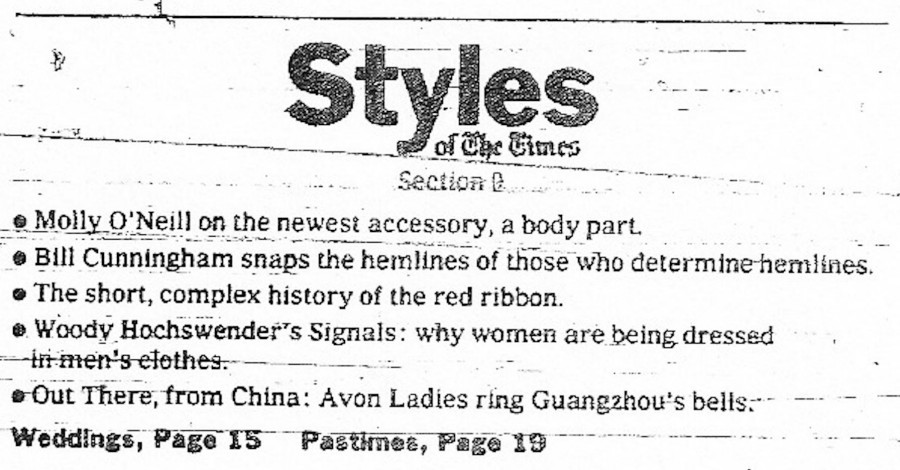
Styles of the Times was then a new Sunday section; it had arrived just six months before to much fanfare. A press release announcing the section’s premiere gasped that it would be “unlike any other section of the newspaper, past or present.” Though the section had the enthusiastic backing of then-newly appointed publisher Arthur Sulzberger, Jr., it was not popular, internally or externally. A month after the new section debuted, New York described it as “loaded with attitude, big pictures, white space — and undemanding copy.” The “grunge hoax” only made things worse. While Marin’s analysis had been nuanced and thoughtful, the obvious stupidity of the glossary debacle only confirmed what critics were already thinking. At the end of the year, Styles of the Times landed the paper on Spy magazine’s annual “Spy 100,” the magazine’s catalog of “the most annoying alarming and appalling people, places and things” of 1992. Styles of the Times was, Spy’s writers said, just the latest example of the paper’s “desperate attempts to seem hip,” with “trends that were already stale, had already been noted by the equally unhip New York magazine, were never going to happen or were simply too bizarre to comprehend.”
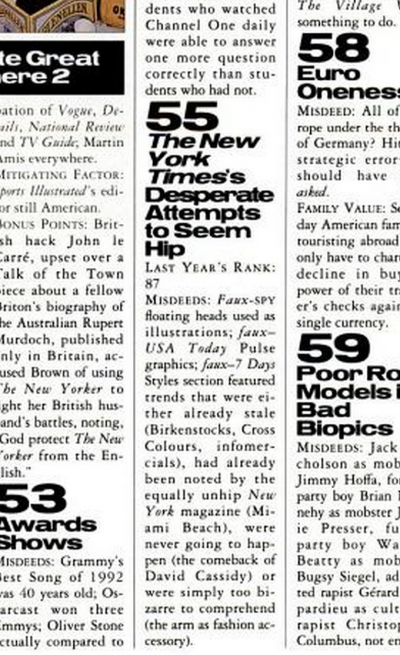
Styles of the Times eventually morphed into “the Sunday Styles section” and its much-loathed Thursday younger sibling. More than 20 years later, the grunge debacle still seems to embody what people say is right and wrong with the Styles section: out of touch, tardy, overwrought, clumsy, as well as presenting uncritical work in the language of the very critical, but also peevish, strange, unexpected and, as an institution, strangely comprehensive and coherent. Like a marathon watching of “Sex and the City,” a sustained reading of Styles reveals more about both the culture and New York City than you might think from a look at a single issue.
Despite its youth, the section has a much longer history, one that encompasses the long effort of women in journalism to be taken seriously as reporters and as readers, the development of New Journalism, large-scale social changes that have brought gay culture into the mainstream, shifts in the way news is delivered and consumed, and economic consolidations and disruptions that the section has, sometimes in spite of itself, thoroughly documented and cataloged. The Styles section may well be pretty stupid sometimes. It’s also a richer and more complex entity than any of us would like to believe.
We read into the Styles section as much as we read it. Is it irresponsible bullshit or harmlessly fatuous? An opportunity for indulging one’s schadenfreude or a cause of the paper’s decline? A sociological or anthropological lens on The Way We Live Now, or an elaborate and unselfconscious justification for “the pleasure of rampant consumerism”? The best way to figure that out is to read it.
Don’t worry; I did it for you.
THE OLD JOURNALISM
If the New York Times Styles section seems like a puzzling amalgam of content that seems to have little to do with “style” (whatever that even means), that’s because it is. The Styles portfolio includes three editorial strands shaped by a number of editors and writers: wedding announcements (a.k.a. “mergers and acquisitions” or the “women’s sports pages,” a term that predates, but was popularized by, “Sex and the City”) and wedding industry reporting; fashion criticism and reporting, a standalone section until 2004; and a somewhat more ambiguous variety of cultural reporting and criticism. The wedding announcements and Vows column are directed and edited by the paper’s Society desk, a distinct entity headed by Robert Woletz, who has held the post since 1994. The “Modern Love” column, a staple of Sunday Styles, debuted in 2004 and is edited by Daniel Jones, who lives in central Massachusetts. Styles is now overseen by Stuart Emmrich, who coordinates this content with beauty, fashion, and culture coverage.
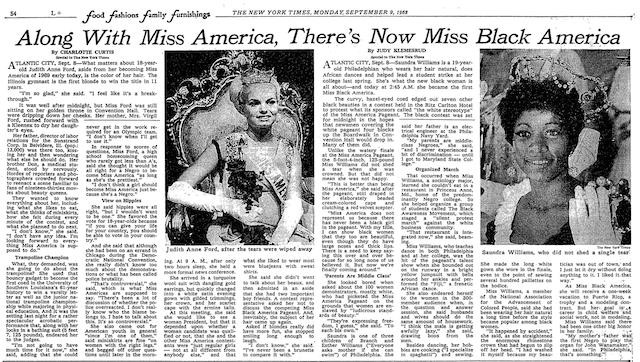
Courtesy Sallie Bingham Center for Women’s History & Culture, Duke’s Rubenstein Library
That these manners of things all run in the same section is a fairly recent development.
In American newspapers, women’s news and society news were always held distinct. In A Place in the News, her history of women in journalism, Kay Mills noted that society news was “taken so seriously” that from the days of James Gordon Bennett Sr.’s New York Herald in the 1840s, “virtually all the society editors and reporters for New York newspapers were men.” The paper ran wedding announcements nearly every day, generally the day after a ceremony, beginning with the first edition in September, 1851. (When Styles of the Times debuted in 1992, they ran on Sundays and Mondays. Two years later, the paper moved to printing engagement and wedding news once a week, on Sundays.)
Women’s news was the opposite of important, with close ties to so-called yellow journalism. Joseph Pulitzer is credited with developing women’s news largely as a means of attracting new readers and, in turn, new advertisers. When Pulitzer bought the New York World in 1883, the paper had already had a “woman’s news” (as they called it) department for over twenty years. Women’s news, such as it was, included articles devoted to beauty, fashion, and domestic life. When Oscar Wilde was appointed the new editor of The Lady’s World in 1887, he noted that women’s periodicals took as their subject “merely what women wear,” not, as he hoped his magazine would, “what they think, and what they feel.” (He promptly changed the magazine’s name to The Woman’s World.)
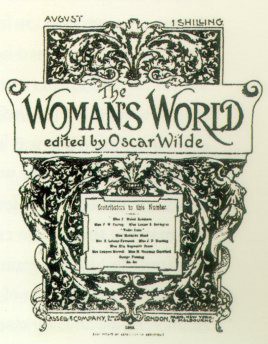
Wilde imagined something grander when he suggested that what women think and feel should be a subject of interest. But women’s news, which quickly became a component of nearly every newspaper, was sensational and emotional, its expectations of its readers limited. By 1891, the New York World had begun the first women’s news section, a weekly “For and About Women” page. Ishbel Ross, a reporter who also wrote the first history of women in journalism, said that Pulitzer’s women, like everyone in his newsroom, were expected to “get a good story or die.” What’s more, they also “had to show their feelings in their reporting.”
Even the most successful women working in journalism had to write to these conventions, fashioning themselves as stunt girls or sob sisters. As Laurie Penny recently pointed out in The New Inquiry, this is how World staffer Elizabeth Jane Cochrane made her name (well, Nellie Bly’s name) as a stunt reporter. “’Gonzo’ journalism is now read as a macho practice,” Penny wrote. “Turn up somewhere ripped and stoned and undercover and immerse yourself in a culture or practice, then write viscerally, from the brain and the gut. In fact, women were doing it first,” because that kind of writing, sensational and sentimental, was what women like Cochrane were permitted to produce.
From its earliest days, the New York Times was a particularly difficult place for women to work. Maybe a dozen or so women worked as reporters and editors in the paper’s first 100 years. From 1896, when Adolph S. Ochs bought the Times, to his death in 1935, only four women wrote for the paper. He hired one of them, Anne O’Hare McCormick, as a freelance contributor in 1921. She was not officially on staff until 1936, the year after his death and the year before she won a Pulitzer Prize for her work as a foreign correspondent. Like McCormick, many of these exceptional women worked as general assignment reporters, city room staffers, and correspondents, even if they also served time on the society desk or the women’s pages.
This wouldn’t change much until the mid-1950s, when Elizabeth Penrose Howkins, who had shaped Glamour and British Vogue into powerhouses, became the editor of the paper’s women’s pages. Women’s pages had by then settled into advertiser-friendly niches: they covered fashion, homemaking, and club news. At the Times, the department was called “Food, Fashion, Family, and Furnishings,” informally known as the “four Fs.” Howkins assembled a staff of a dozen talented women, many of whom later went on to more august roles at the paper. They included future Pulitzer Prize winner and Washington correspondent Nan Robertson; Betsy Wade, the first woman hired to the copy desk, the editor of the Pentagon Papers, and the lead plaintiff in a landmark 1974 sex discrimination suit against the Times; Gloria Emerson, who went on to cover the Vietnam War for the paper; and Marilyn Bender, the first woman to edit the business section.
In her memoir The Girls in the Balcony, Nan Robertson wrote that when she arrived at the paper in 1955, the women’s department was the paper’s “dirty little secret, tucked away by itself far above the city room; it provided the sop to the people who bought space in a newspaper that elsewhere in its columns gave the news,” as Adolph S. Ochs had famously said, “impartially, without fear or favor.” So marginal was the section that it was on the building’s ninth floor. The society desk — the two wouldn’t be combined until 1965 — was in the third-floor city room.
Editors and reporters, especially the women often consigned to writing for them, hated the women’s pages. Lindsy Van Gelder, the New York Post reporter who coined the phrase “bra burning,” wrote in Ms. in 1974 that when she became a journalist, she “avoided the women’s-angle assignments through a maniacally macho willingness to cover train wrecks, riots, anything else, and an unfeigned ignorance of conventional women’s-pagey topics.” The talented women on Penrose’s staff felt the same way; Robertson was relieved when she was transferred to the city room in 1959.
Precisely because they were so marginalized, because so little was expected of them, there could be more going on in the women’s pages than first met the eye. The women’s pages could sometimes be a space for experimentation. This was somewhat like Tom Wolfe’s sense that he had freedom to experiment in the pages of New York (then the New York Herald Tribune’s Sunday magazine) in 1963 and 1964, because Sunday supplements were “close to being the lowest form of periodical… well below that of the ordinary daily newspaper, and only slightly above that of… sheets like the National Enquirer in its ‘I Left My Babies in the Deep Freeze’ period.” Women’s reporting could be a place where reporters wrote pieces that were wryly complicated, even critical of, their subjects and topics. Judy Klemesrud wrote some of the paper’s earliest and best coverage of the women’s movement. In 1966, the year Klemesrud was hired, a story about the founding of the National Organization for Women appeared under a piece about Thanksgiving recipes.
At the Times, such subjects were the purview of Howkins’ writers, including Bender, Emerson, and particularly reporter Charlotte Curtis, who was hired by the Times women’s section in 1961. Though Curtis, like many women, took the job hoping it would enable her to move into straight news reporting, she spent the next 13 years changing the genre entirely.
ENTER CHARLOTTE

Born in Chicago and raised in Columbus, Ohio, Curtis got into the newspaper business in the late 1940s, when she applied for a summer newspaper job at the Columbus Citizen after her freshman year at Vassar. After she graduated in 1950, she took a full-time job at the paper, where she spent the next ten years.
Curtis was vastly ambitious and extremely resourceful. Her editors at the Citizen gave her rare autonomy, which she used to great effect, bringing considerable critical depth and sophistication to the women’s pages. During the 1960 presidential campaign, she profiled Rose Kennedy, skewering Camelot’s sainted matriarch under the headline “Mother Comes To Town.” Rose Kennedy, Curtis makes clear, is cosseted and demanding. Covering a midday press appearance, for which Mama Rose is turned out in Oleg Cassini, alligator shoes, and a pile of gold, diamonds, and pearls, Curtis simply documented everything Kennedy did. Mrs. Kennedy…
said she was too warm, that someone should turn on the air-conditioning and that if there were going to be pictures, she’d like to put on a hat and gloves. She disappeared into her bedroom and returned wearing a white wool toque. She worked her small hands into long white kid gloves while the television cameras were set up. And someone found a pillow so she would be more comfortable.
‘If we’re going to be on television, I wish you’d tell me what questions you’re going to ask,’ she said…. ‘I don’t answer political questions. I talk about the way the children were brought up…..’ The reporters continued their questions. The cameras ground on. And Mrs. Kennedy pulled out a jeweled compact and powdered her nose.
In 1960, Curtis applied for an opening as a home furnishings writer in the Times’ women’s news department, hoping for a foothold. Penrose, despite misgivings that Curtis would find the job boring, hired her.
Her stories at the Times were droll and they often captured unusual sociological observations. “Piñata Shop’s Specialty Not Piñatas,” was the headline for a piece she wrote in August, 1961, a story that, up front, points out that the store relies on a stereotypical image of Latin America in order to attract business. Piñatas, her subject George Grossblatt points out, are “Mexican or Central American,” while his business actually specializes in Peruvian imports. “We carry piñatas because we have to.”
The following month, she profiled the Traffic Department’s year-old “100-woman parking-meter attendant brigade” in a story headlined “Judo and Make-Up Aid Meter Maids.” Among other details, she reports that the meter maids fix jammed meters with keys or nail files and that they were “forbidden to enter bars, smoke on the streets, wear earrings or necklaces, carry packages.”
Covering fashion in 1961, she let Japanese designer Hanae Mori hang herself with her own quotes: “Maybe I’m mistaken, but I find nothing very American in New York. I had expected something different. It appears that your fashions are very much influenced by France and Italy.”
Curtis also filed a report on the daily Scandinavian gymnastics class for women staffers at the United Nations, where, she said, “a band of internationalists… is waging its own battle of the bulge.” Also on the U.N. exercise beat: the t’ai chi program for “tired diplomats and members of the Secretariat.” The following spring, she reported on the host of the NBC exercise show “Slimnastics.”
Soon enough, she was offered an out from the women’s desk — but not the one she’d been looking for. She’d just been approved for a transfer to the third floor newsroom when she met Clifton Daniel, who became the paper’s managing editor in 1964. Daniel’s midlife marriage to Margaret Truman a few years prior had thrust the pharmacist’s son into the edges of high society; he found it fascinatingly absurd. While he had urged the Society editor, Russell Edwards, to push the section toward reporting on, not just recording the details of, the lives of the upper class, he had had little luck. But in Charlotte Curtis, who once told a New York Times Oral History Project interviewer that “the techniques of reporting are the same regardless of what you do,” he saw someone who would be able to “write about society as news and to treat it as sociology.” He coaxed her to move to the society desk, with a promised transfer to features if she didn’t like it. Instead, she transformed the paper’s coverage of society topics and attracted national attention to her work.
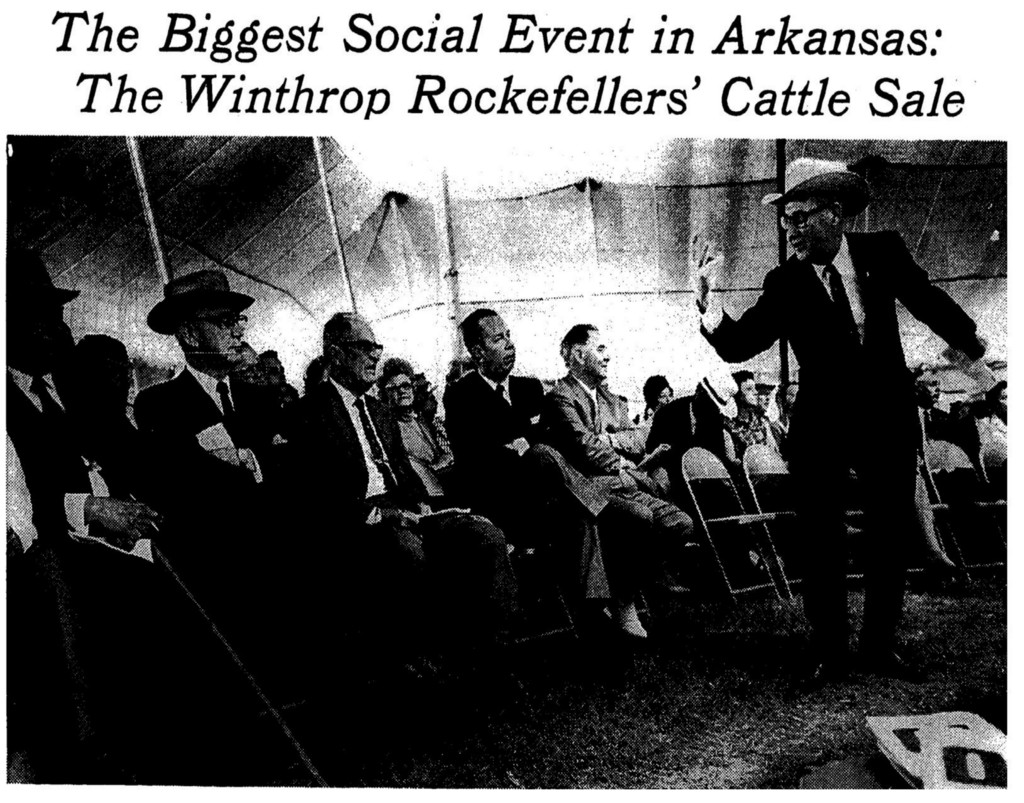
Curtis remade the paper’s society section (and, after 1965, a combined “women’s news” section) into a place for trenchant social critique and the candid examination of how wealth and power operated in New York and beyond. She filed reports of social scenes in cities across the country — not just in New York, but in Palm Springs, San Francisco, Los Angeles, Newport, Miami Beach, and Grosse Pointe, MI. She also filed reports from somewhat less expected locales, covering “The Biggest Social Event in Arkansas: The Winthrop Rockefellers’ Cattle Sale” at Winrock Farms, the home of the Arkansas governor. The ranch, she noted, “had not yet shoved Palm Beach, Newport, or San Francisco’s better suburbs completely out of the American society picture. But its grass will always be a little greener. The Rockefellers spray it with vegetable dye.”
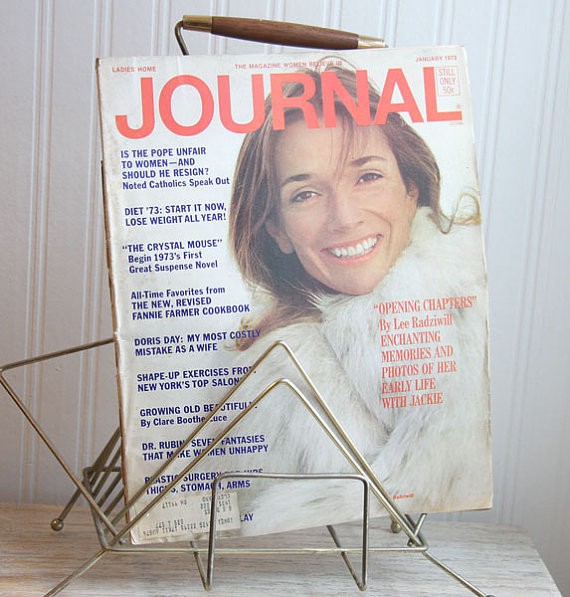
She drew attention to the self-referential and self-obsessed logic that drove social life. She wrote a story on a party that Ladies’ Home Journal threw for Princess Lee Radziwill (née Caroline Lee Bouvier) after publishing “her first 1,000 word article and snapshots in its January issue. The one with her picture on the cover.” The headline? “A Princess Writes A Story, and That Makes It A Party” — a party attended by her sister Jackie, John Kenneth Galbraith, Truman Capote, and Norman Mailer. (“They write, too.”)
She examined how names ascended to — or toppled from — lists of boldfaced names, filing, for example, updates on the year’s new edition of the Social Register — which, she wrote, was “founded 76 years ago by a man who owned a gossip sheet.”
“It lists few members of minority groups,” she noted frankly in 1963, “preferring white protestants. It rarely explains its inclusions and deletions,” such as why Governor Rockefeller and his new wife remained in the 1964 edition of the Register when so many others were dropped because they divorced.
Her work was certainly noticed, if not well remembered. (Curtis’s life and work have received little critical attention, with the exception of Marilyn Greenwald’s 1999 book, A Woman of the Times, which provides a much more thorough look at her career.) In 1965, Time profiled her, amused and surprised by the “first society reporter in journalistic history to publish the fact that proper Bostonians sweat.” But her reputation was always narrated in a specific way — that Charlotte Curtis, Lady Reporter, was revivifying women’s news. And so her larger contributions to journalism were overlooked.
STATUS MARKERS
At the same time that Charlotte Curtis was rewriting society, reporters like Gay Talese (who had by then left the Times), Tom Wolfe, and Jimmy Breslin were playing with narrative nonfiction and people were calling it New Journalism. The genre’s development is told as an aggressively masculine story. According to Wolfe’s now-canonical history, the New Journalism emerged in the late 1950s or early 1960s; it was in 1962 that he read Gay Talese’s profile of boxer Joe Louis in Esquire and thought, “What the hell is going on?” Around the same time, he noticed a similar shift in his colleague Jimmy Breslin’s writing for the Herald Tribune.
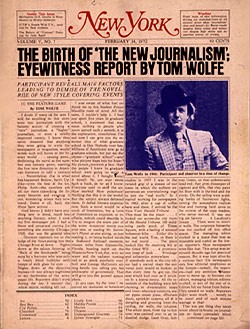
The following year, Wolfe famously churned out 49 pages of notes for a story on custom cars — what “I thought was merely a memorandum” — to his editor at Esquire, who apocryphally merely removed the salutation and ran the notes as a feature. It was in this period, Wolfe says, that his version of the New Journalism really began to crystallize. While keeping him on the city desk two days a week, the Tribune assigned him a weekly feature for New York, still the paper’s Sunday-supplement magazine, which gave him room to experiment. Because neither editors nor readers expected much, Wolfe could experiment with literary structures and narrative strategies.
Other writers joined this history. Didion’s California essays, eventually collected in Slouching Toward Bethlehem, began appearing around 1964. Capote’s In Cold Blood came in 1965. In 1973, Wolfe published The New Journalism, an anthology of work from 23 exemplars of the form (two are women), and two long essays in which he laid out his theory of the genre.
But what was it? Wolfe said New Journalism relied on four devices: scene-by-scene construction; the use of reported dialogue; “third-person point of view”; and what Wolfe called “status details” — the “everyday gestures, habits, manners, customs” of the subject. (In true Wolfean style, of course, his complete definition goes on for another 89 words.) This, he said, was a strategy that nonfiction writers had learned from the literary masters — Balzac, Dickens, Gogol.
It certainly wasn’t the province of journalists: “I have never heard a journalist talk about the recording of status life in any way that showed he even thought of it as a separate device. It is simply something that journalists in the new form have gravitated toward.”
All of this, he said, involved a “more intense, more detailed” style of reporting “than anything that newspaper or magazine reporters… were accustomed to.” It was not, Wolfe felt, a style for writers facing the constraints of space and deadline.
At this same time, feminism and changes in journalism — or taste — led editors to reconsider the concept of women’s pages entirely. Many papers simply dropped the moniker. Others did more. On January 6, 1969, the Washington Post launched a new standalone Style section, eliminating the category of women’s news and doing away with engagement and wedding announcements entirely. According to Ben Bradlee, who had recently become the paper’s executive editor, the new section was meant to “treat women as people and not appendages to men” and to better organize the paper by bringing into one place anything related to “what people do in their non-professional lives.” Bradlee insisted on staffing the new section with both men and women, including reporters from the general assignment pool. The Los Angeles Times debuted a similar “View” section the following year.
However Tom Wolfe might have felt about it, style reporting, particularly at the Washington Post, was deeply linked to New Journalism. In 1975, the Post released pieces from Styles’s first five years in an anthology. In the collection’s introduction, editor Tom Kendrick argued that by adapting New Journalism’s literary strategies to the demands of the deadline-driven newsroom, his reporters had advanced a new reportorial mode. Call it style journalism, he suggested. His reporters, he said, used these methods to “explore the changing role of women, the expansion of leisure time” — “to chart the leading edge of a torrent of social change” after the “extinction” of the women’s pages.
The New York Times lagged behind. Under Charlotte Curtis’ watch in 1965, the paper had combined society and women’s news into one section — but the paper did not create its “Living Style” from the ashes of the women’s/family pages until 1978.
And yet. Charlotte Curtis’s work throughout sounds considerably like style journalism. Way back in 1960 she skewered Pat Nixon with status details and reported dialogue. If she did not execute Wolfe’s prized scene-by-scene construction, she met its object, which was “resorting as little as possible to sheer historical narrative.” Her pieces were tightly observed scenes. In 1968, Curtis was the first reporter off Robert Kennedy’s funeral train in Washington, D.C., where television cameras captured her charging up to Kennedy’s brother-in-law Stephen Smith and barking “Where’s the goddamned telephone?”
The piece began this way:
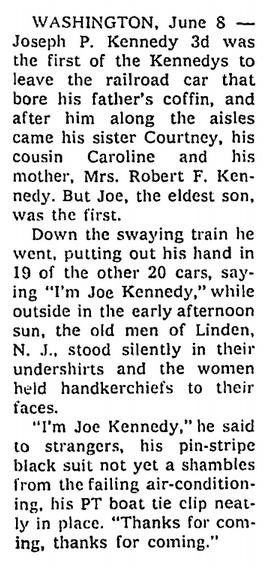
It was, like the best of her work, richly textured, evocative, and telling. It continued to be described as women’s journalism. In 1969, New York published feature writer Julie Baumgold’s glowing profile of Curtis, which described her as changing women’s journalism — not, as Kendrick wrote loftily of the Post’s style reporters, journalism itself. In 1965, Baumgold wrote, when “the woman’s universe was lifting its face,” the newly promoted Curtis “changed the character of the Four F’s.” This was how others saw it, too, including Wolfe.
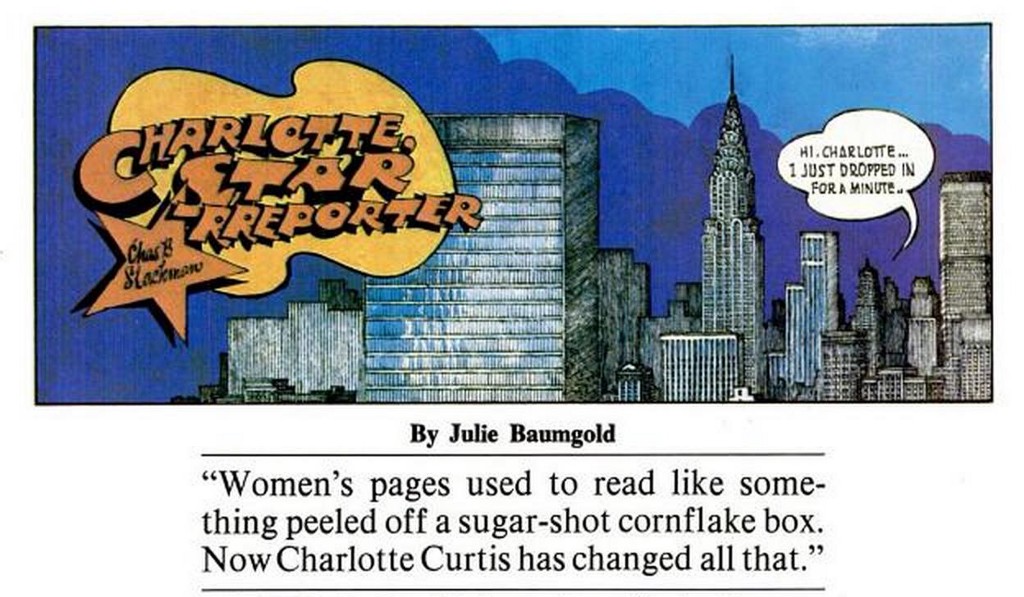
This we know because the two encountered one another in January 1970, at a cocktail party benefit for the Black Panthers, hosted by Leonard Bernstein and his wife in their Park Avenue apartment. The party’s lasting infamy is a result of Wolfe’s 25,000-word story, “Radical Chic,” which was first published in the June 8, 1970 edition of New York.
In this case, Charlotte Curtis — “women’s news editor of the New York Times, America’s foremost chronicler of Society, a lean woman in black, with her notebook out” — was part of Wolfe’s story. “Radical Chic” narrated both the party — “Lenny says: So you’re going to start a revolution from a Park Avenue apartment!” — and the subsequent fallout, ignited when Curtis’s story about the event appeared twice in the Times, in that evening’s first edition and in the next morning’s paper. “Her story was not in any way critical of what had gone on,” Wolfe wrote, implying that the party might not have garnered any controversy, except for the fact that, because the paper sent Curtis instead of someone like Homer Bigart, “the Bernsteins probably did not realize at first… that the story was going out on the New York Times News Service wires.” It ran “to an international chorus of horse laughs or nausea, depending on one’s Weltanschauung.”
In this account, what Charlotte Curtis did and what Tom Wolfe did were quite different, a belief he still holds. Earlier this year, Elon Green broke the piece down with Wolfe for the Nieman Institute’s Storyboard annotation series. Of Curtis’s story, he says, “She did a very good reporting job, but it didn’t go beyond it, emotionally.” Yet what Curtis’s early edition story seems to lack is mostly Wolfe’s aggressive narrative persona. (The first edition, published the night before, is more reportorial, though it, too, has some zingers.) The lead paragraph is fairly standard newspaper fare:

But what follows from Curtis is not, as these three short excerpts suggest:
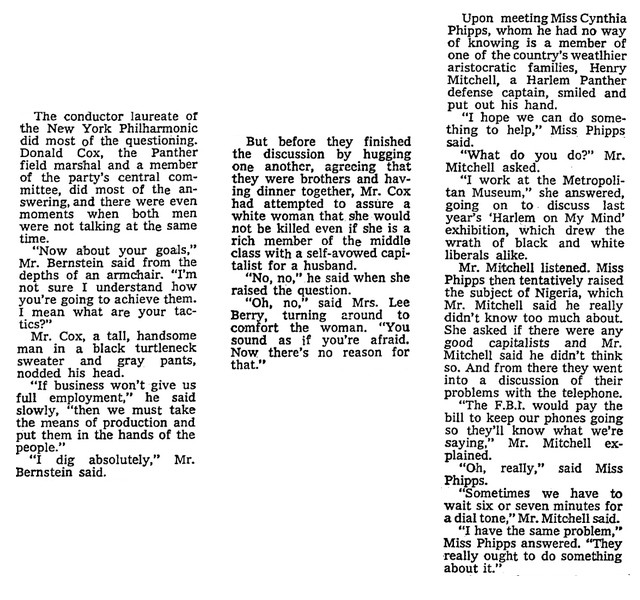
Equally cutting are the last paragraphs, which describes the solicitation of donations for the Black Panther Party:
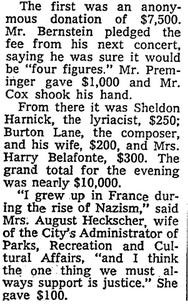
The constraints (and necessities!) of newspaper work make the texture of what Curtis could create different from the text of a magazine piece. But the qualities that Wolfe himself named as essential to the New Journalism could absolutely be found here in the beleaguered women’s pages. What was women’s journalism if not finely observed details about what people wore, how their homes looked, what their manners and gestures were? Over and over again, Charlotte Curtis used them to devastating effect. More than any writer working regularly, she successfully achieved Wolfe’s ambition of recording “people’s status life, using that term in the broad sense of the entire pattern of behavior and possessions through which people express their position in the world or what they think it is or what they hope to be.”
But Curtis was the Times’ “social editrix,” a women’s news reporter, working for a section her peers dismissed. Never mind that Talese and Curtis overlapped at the Times. Never mind that an internal readership study conducted in 1973 suggested that the family/style pages were the most popular in the newspaper.
Style journalism couldn’t shake the misogynist associations of the women’s pages so easily. In 1974, Post columnist Nicholas Von Hoffman told Lindsy Van Gelder, “One of the most frequent questions I get is ‘Don’t you resent being put on the women’s page?’” Two years later, the Post added a “Style Plus” page to the section, which carried “articles about careers, personal finance, family questions” and advice. While Shelby Coffey, who edited the section from 1976–1983, said that Style Plus was an effort to remedy the problem of having overlooked “areas of family life of concern to both men and women,” it’s hard not to see it as an effort to draw more male readers to the section. In retrospect, that seems obvious: the section, complete with a regular column called “Coping,” had a thick air of Cathy Guisewite about it, even as late as May of 1979.


In 1974, Charlotte Curtis was promoted to associate editor of the op-ed page and became the first woman in the paper’s history to appear on the masthead with senior staff. Her legacy, however, was mixed, and she was pretty racist, at a time when black reporters and editors could have used an ally. She made clear that she was not a feminist and felt no solidarity with other women at the paper; Marilyn Greenwald has pointed out that women did not become part of the paper’s “power structure” for another decade after Curtis became associate editor. When Betsy Wade Boylan led a class action sex discrimination suit against the paper in 1974, Curtis refused to join, claiming that she could not do so as a member of the management. Still, when Anna Quindlen was promoted to deputy metro editor in 1983, Greenwald says that Curtis offered her this regretful advice: “You will only have as much power as they wish you to have. Don’t fool yourself as to what this promotion means. Do the best you can for yourself and other women and don’t blame yourself if that’s not enough.”
Her promotion was accompanied by the slow, confused end of the “women’s pages.” Feature and lifestyle content were now delivered in five rotating sections, including a sports section, Science Times, Living, Home, and Weekend. The lifestyle sections, missing Curtis’s edge, struck observers as increasingly elitist. In 1977, Earl Shorris wrote in Harper’s that the sections were “daily affronts to one’s sense of proportion in the world,” predominated as they were by “food, fashion, or fun.” Shorris, a novelist and social critic who often wrote about poverty and capitalism, charged that the paper as a whole ignored real issues of concern in favor of serving the affluent: “A reader of the Times can be comfortable living in a nation where at least 25 million people, almost half of them, suffer poverty… in a city where… entire neighborhoods have been burned out or left to rot.”
Shorris argued that the paper had become more feminized and “reflected the blatant reduction of journalism to a business.” Much of Shorris’s vitriol echoed many of the earlier charges against the women’s pages. The Times had “always been a service for the affluent, with particular emphasis on affluent men,” but, he thought, it had become “a service for affluent women as well.” The new sections, focused on gossip and acquisitiveness, were services to “the mean-spirited [and] the envious” — and they were directed at women.
He more than implied that they had emasculated the paper: “the editors of the Times seem to view [women readers] through the lovingly disdainful eyes of mother-dominated sons.” The Times’ lifestyle coverage has been dogged by similar complaints ever since.
A STYLES IS BORN
Styles of the Times certainly grew out of an effort to achieve deeper metropolitan circulation — aimed, as media critic Edwin Diamond once sneered, at “young, downtown trendoids.” (Diamond, writing for New York magazine, was 66 at the time.) In 1991, managing editor Joe Lelyveld hired on Adam Moss to help the paper develop a more robust Metro section and better manage the disparate lifestyle content that had been in a section known internally as Sunday Main Part 2. Moss, then 34, was the founding editor of the short-lived but splashy downtown weekly 7 Days. Along with Lelyveld and Tom Bodkin, the paper’s chief designer, he developed Styles of the Times, which was, like Metro, aimed at a local audience.
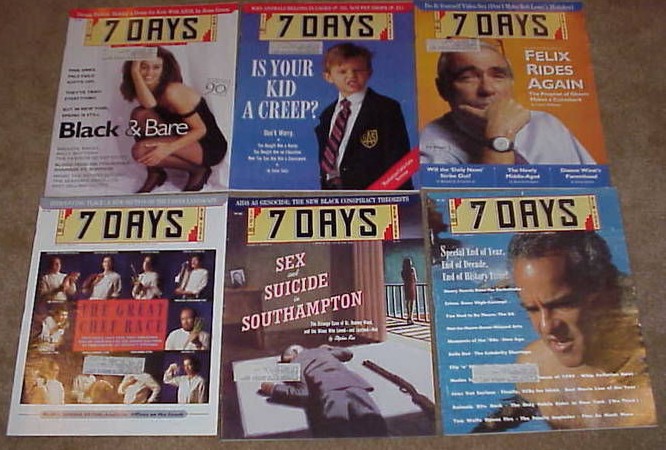
Styles of the Times debuted on May 3, 1992, edited not by Moss but by Stephen Drucker, a former Vogue editor who had been editing the Home section since 1988. Nearly from the first, it was unpopular, in no small part because the Times’ expectations for it were breathlessly absurd. Drucker promised: “The way the foreign desk takes people to Afghanistan, we’ll take people to nightclubs, restaurants and subcultures they might not normally get to see.” (The paper had certainly been doing that though for at least a decade.)
And then the section’s debut cover story was, much to the bemusement of media critics, “The Arm Fetish,” a lavishly illustrated story arguing that the “sculptured body is now the foundation of fashion. And the arm is the advance man for the rest of the form.” Reporter Molly O’Neill — sister of the Yankee right-fielder Paul O’Neill — traced the origins of the aesthetic to Arnold Schwarzenegger and the Terminator franchise, talked to personal trainers, fashion designers, the head of the Women’s Division of Ford Models, plastic surgeons who were seeing “increasing concern for ‘batwing deformity,’” and the executive vice president of a mannequin company. (This might also have been the first documented incident of the section arriving far too early for a trend; 17 years later, Styles featured a story about Michelle Obama’s arms weeks after the media had churned her sleeveless wardrobe into what the Huffington Post had already dubbed “Sleevegate” and Maureen Dowd had come to her defense.)
Styles of the Times as an attempt to generate new advertising revenue for the paper immediately made it suspect in some quarters–much like the women’s pages before it. The new section allowed the Times to move a marquee Saks Fifth Avenue ad out of Section A and into somewhere that seemed more suitable.
And, in a new variation on criticism of the paper’s lifestyle coverage, Styles almost immediately began attracting the charge that the Times was getting pretty gay. “Regular Times readers,” Edwin Diamond wrote, in 1993, “have become convinced that an implicitly ‘gay voice’ resonates throughout the paper these days. Actually, the attuned listener is picking up some, but by no means all, of the Times’ new signals.”
“A recent page-one feature on the drag queen Angie Xtravaganza brought letters of protest,” Diamond noted, including a charming piece of correspondence from one Ronald Judd Moore of Brooklyn:
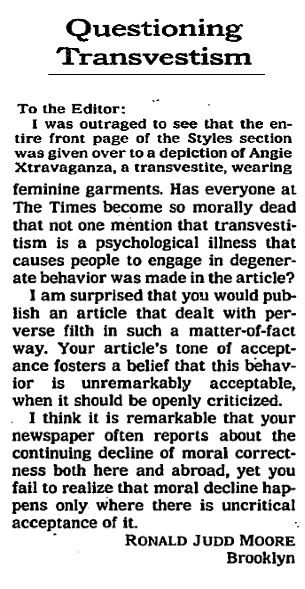
But was the newspaper becoming gay? Actually, yes!
Until executive editor A.M. (Abe) Rosenthal retired in 1986, reporters were banned from using the word “gay” in print (much less being comfortably out at work). Two weeks after Sulzberger succeeded his father as publisher in 1992, he told the editorial staff that “diversity [and] sexual orientation” were new priorities. In the months that followed, according to the Advocate, “it seemed like all manner of gay and lesbian news was suddenly fit to print on the paper’s pages as well” — not just in the form of aggressive coverage of the AIDS crisis, but in stories about “suburban gays, Jewish gays in search of a rabbi, powerful lesbians in the gay and lesbian civil rights movement, the paucity of gay and lesbian characters on television.”
All of these stories were published before Styles of the Times had even launched, though Adam Moss may have had something to do with them. While working with Lelyveld on the section, insiders said that Moss, who is gay, was “very vocal and has an effect on the newsroom regarding gay issues.” His new section likewise included stories on “gay rodeos, a clothing store that specialized in lace-up ‘bondage trousers,’ and the various joys of Billy Idol and cyberpunk.”

While Edwin Diamond described Styles of the Times as a “Kafkaesque growth on the body of the old, familiar Times,” others were less fazed by the question of the section’s orientation. Allure editor Joan Kron told him, “It’s become fashionable to say that you hate ‘Styles.’ Well, I think it’s great that it exists… ‘Styles’ reflects the creative fields of fashion, design, interiors: the world has a ‘gay sensibility.’”
But the jokes had their intended effect. Styles also was not as successful with advertisers as one might have thought. In June, 1994, Styles of the Times was reduced to four pages and folded into the back pages of the Metro section. It wasn’t until 1997 that it was relaunched as “Sunday Styles” — and attracted less controversy. In 2004, the popular Modern Love column began and fashion and beauty coverage were brought into the section; in April, 2005, an additional “Thursday Styles” section made its debut. Within four weeks, readers began calling it “Thursgay Styles,” and by early July, the appellation had popped up on Gawker.
When readers were invited to ask Trip Gabriel, editor from 1998–2010, questions in the regular online “Ask the Editors” feature in 2007, they asked about issues that still occupy the section’s fans and foes: whether the section is only for the affluent; why there’s so much advertising; what’s really going on with pleated pants for men; what exactly Bill Cunningham is up to (the question implying that Bill Cunningham is some sort of shill, which should offend everyone, because Bill Cunningham is perfect in every way); and how you get a wedding announcement listed in Weddings and Celebrations. (This last question has been a source of keen public interest for at least 35 years.)
And, of course, there were several questions about why there were so many stories about The Gays and whether “Thursgay Styles” was an insult or an accurate description (or both). Gabriel was blunt:
On Gawker’s Thursgay thing: As far as “Thursgay Styles,’’ it strikes me as kind of retro that a blog presenting itself as cutting edge about media and celebrity gossip would equate an interest in men’s fashion with being gay. Wasn’t that your grandfather’s thing? Thursday Styles includes a small amount of men’s fashion, mainly an every-three-weeks column, Dress Codes, but we are much more likely to cover aspects of gay life in Sunday Styles.
Gabriel was right, of course, about how retrograde it is to deride a fashion section for being too gay. But he was also correct. As it turns out, Styles’ critics are just as bad at spotting trends as they think the section is: “Thursgay Styles” wasn’t real. It was not a real phenomenon. Many of the stories derided as “gay” don’t actually use the word or make reference to any variety of gay people at all, and it’s not as though the section is particularly coy about it when they do. Instead, the criticism is based on hearing a dog whistle that no one is blowing — we react to whatever resonates with what our ideas of gay subjects might be because we’ve internalized them.
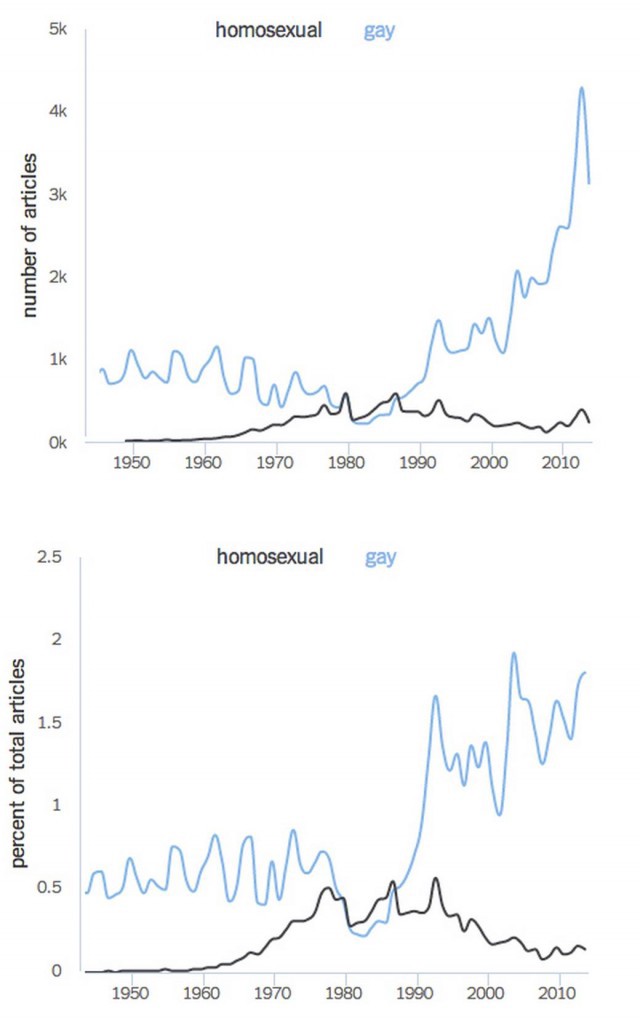
Above: Historical usages of the words “gay” and “homosexual” in the New York Times, from the NYT Labs Chronicle. The paper began using gay to mean homosexual after 1986. Chronicle is sensitive to ambiguity, and so a search for “gay” may include a small amount of people’s surnames and company names, but Chronicle does not pick up partial words.
This two-decade obsession with whether the Styles section is or isn’t gay never seems to take into account the extraordinary shift in public discourse about non-heterosexual people, which is a subject we might expect the self-styled Paper of Record to cover in some depth. In the two decades after 1992, in the U.S. alone, the murders of Brandon Teena, Matthew Shepard, Gwen Araujo, Rita Hester and eighth-grader Larry King made national headlines; openly gay, lesbian, and transgender people were appointed to Cabinet-level posts, federal judgeships, elected to the U.S. House and Senate; a life-extending treatment for AIDS was discovered; Congress passed the Defense of Marriage Act and the Supreme Court overturned it; the Defense Department issued and lifted the Don’t Ask Don’t Tell directive; 27 states and 3 tribal governments passed bans on same-sex marriage; 21 states, the District of Columbia, and 10 tribal governments legalized same-sex marriage. Also, Ellen DeGeneres hosted the Oscars. (Never forget.)
People certainly perceived a significant increase in stories about The Gays in Styles. It’s possible, maybe even likely, that more of the paper’s gay coverage was shunted to Sunday and Thursday Styles after 2005. But we call that “a reporting ghetto,” not “an editorial policy.” If the observation is accurate, what it really suggests is that the rest of the paper wasn’t getting gay enough, even though a 2005 internal study went out of its way to say that it endorsed the view of its first public editor, Daniel Okrent, “that the overall tone of our coverage of gay marriage, as one example, ‘approaches cheerleading.’ By consistently framing the issue as a civil rights matter — gays fighting for the right to be treated like everyone else — we failed to convey how disturbing the issue is in many corners of American social, cultural and religious life.” With an attitude like that in the paper, we should be thrilled to see a breath of fresh air on Thursdays.
HATE-READS
In its prime, the hating of the relaunched Styles section became something of a cheerful blood sport. Each week, media critics and hangers-on at a number of blogs (both with and without associated print publications) gleefully flay Thursday and Sunday Styles features for being too late to cover some trends (e.g., a fetish for the sexy UPS guy; “push presents” for new mothers), too early to cover others (e.g., male topknots), or for “desperately” inventing them in order to assert the section’s relevance (e.g. ,the popularity of the monocle). Section reporters are criticized for writing that is either too earnest or too satirical. When current Times Public Editor Margaret Sullivan unpacked the monocle story, Brooklyn Magazine concluded that the Times openly “admits its trend pieces are bullshit.”
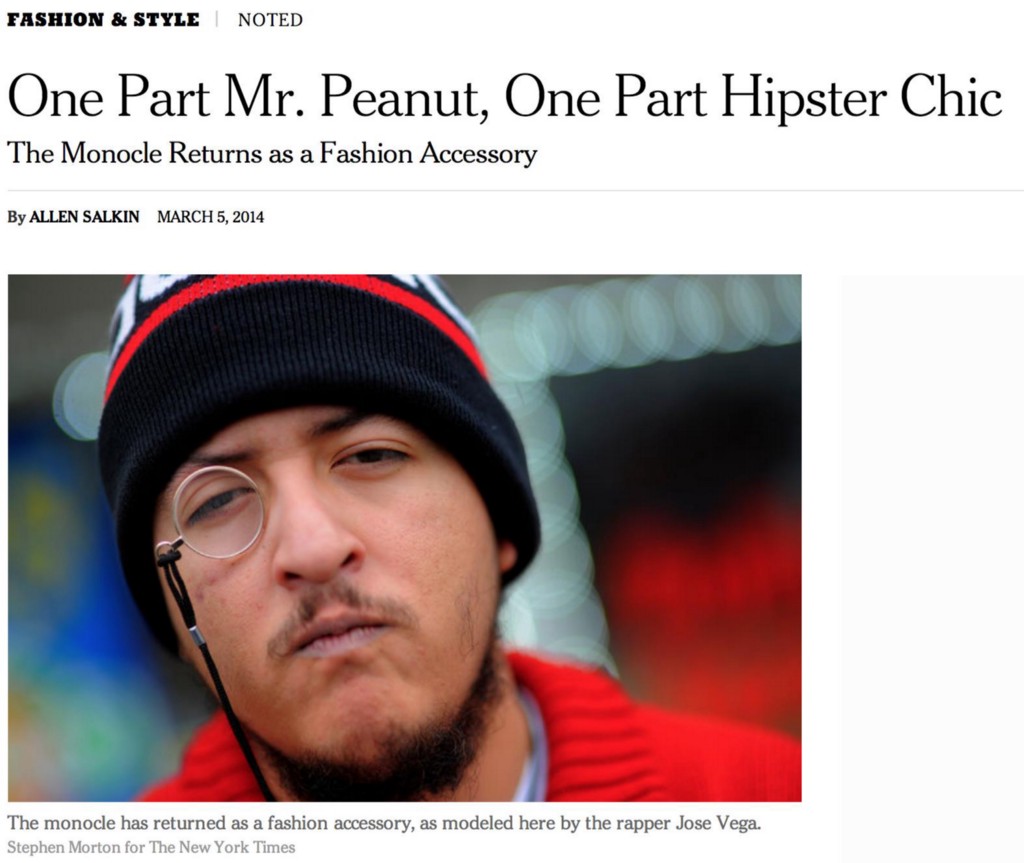
Journalists and writers have charged that the Styles section is characterized by specious and irresponsible reporting. Journalist and media critic Jack Shafer, who worked at Slate from 1996 to 2011, has been one of the section’s most regular critics. During his eight-year tenure as the site’s editor at large, Shafer devoted his Press Box column to rooting out egregious trend reporting across the media landscape. Assisted by an eager audience, Shafer took down dozens of examples of shoddy journalism, unpacking faulty logic, criticizing headlines and decks that overstated an article’s claims, pointing out “weasel-words” (some, few, often, seems, likely, more, many) that are red flags for a shortage of supporting data, and attacking anecdotal evidence with hard data.
Though he often covered “bogus trend stories” that appeared elsewhere in the Times, including on Page One and in the Times Magazine, Shafer reserved the most scorn and derision for the Styles desk, suggesting that the section was lightweight, perennially irresponsible and lazy. He compared Sunday Styles to “the old-fashioned supermarket tabloids” because it “exists to advance the bogus” and said “it knows that it’s a stinking pile of entertaining trash and makes no apologies for it.”
Those charges met no defender. In 2010, The Poynter Institute, the nonprofit media institute that trains journalists and acts as something of a clearinghouse for journalistic ethics, published “How Slate’s Jack Shafer Calls Out Bogus Trend Stories” on its blog. The piece was written with the assumption that Shafer’s criticisms are valid and that the stories he’s criticized are based on “unsubstantiated premise[s].”
Yet the baldness of these accusations doesn’t quite align with the data. Despite consistently arguing that the section’s editors and reporters were consistently professionally irresponsible, only nine Styles stories captured his attention in the eleven years he wrote Press Box: three in 2008 and 2009 and then six in 2010 alone. Since he began his tenure at Reuters after his 2011 layoff, he appears not to have taken the section to task at all.
Concerns about the paper’s ethical and ideological purity seem piqued by its coverage of subjects historically addressed to women, especially while the rest of the paper gets a pass. None of the reporters found responsible for invented, untrue or plagiarized stories in the last 15 years — among them Jayson Blair, Rick Bragg, Michael Finkel, everyone who touched and oversaw the Iraq WMD stories — wrote for the Styles section. And the Times reporter who exposed a completely fabricated Slate story — a story edited by Jack Shafer — was Alex Kuczynski, who, after her appointment on September 10, 2001, ruled as the queen of Styles writers for years.
But it’s the Styles section that we routinely accuse of sloppy, or bad, or gay, or silly journalism. This allows us to continue to believe the story the New York Times has told us about itself for over a century. All the news that’s fit to print” and “without fear or favor,” the most famous lines about the paper’s vaunted commitment to objectivity, were, after all, its own inventions.
WHAT’S IN A STYLE
I catalogued the content of Thursday and Sunday Styles in the months of May and October over a period of nine years: 167 separate sections of Thursday and Sunday Styles covering 88 weeks. (I did not look at wedding-related content, Modern Love, coverage of benefits and galas, bar and restaurant reviews, or runway reviews.) Yes, it does function as a powerful critical lens on contemporary life. Yes, it is devoted to the pleasures of affluence. Yes, sometimes it is absurd. And yes, the writers and editors do seem pretty self-aware about all of these things.
There were far fewer stories than I expected about cats (3); fedoras (1); Target (3); yoga (6, though one covered a very serious yoga community debate about the politics of using a mat, so that should probably count twice); Tim Gunn (1); third-wave coffee (1); Facebook (8); kale (1); David Foster Wallace (1, and it was actually about Karen Green); Oakland (1); or Brooklyn as a hipster enclave (1, maybe 2). I only labeled six stories as an “improbable trend piece” (e.g. people who don’t wear deodorant; scarves you can wear as dresses; “ugly is in”). I only tagged one, about whether the fashion industry oversexualizes male underwear models, with “oh you’re fucking kidding me with this.”
There were also profiles of Robin Roberts, Esperanza Spalding, and Sandra Tsing Loh; a story about what a badass lady Ann Richards was; and fashion history pieces about Mary McCarthy’s style and Bill Blass’s work as a military designer. I found pieces about queer couples who don’t believe in marriage; racist backlash against Disney’s first African American princess; the origins of the Guy Fawkes mask that became an Occupy Wall Street symbol; club kid Michael Alig’s life after he was released from prison; style in the Democratic Republic of Congo; and digital and mobile approaches to sex education. I read a lot of dumb stuff, but I read a lot of really great stuff, too.
The section actually does capture trends, or at least taps into some sort of zeitgeist by documenting what preoccupies, worries, fascinates, and excites. We may not like what we see reflected there, but it’s not invented either.
Vegan muffins, yoga studios and destination pizzerias: Ridgewood, Queens, has them all. http://t.co/kETCB8hQsA pic.twitter.com/e6vttHnzoU
— NYT Styles (@NYTStyles) November 7, 2014
The Styles section, most of all, has captured the evolution of our many anxieties about technology. Earlier digital culture coverage was anxiously existential, concerned with whether the Internet was merely changing our habits or fundamentally altering our values. In the mid-00s, the section covered the new excess of digital photos, how changing modes of viewing affect our beauty standards, what the re-emergence of the audiobook means about cultural literacy, why we hear phantom cell phone rings, and (of course) how teens’ Internet use affects their social development. This may all seem somewhat tedious now, but for a lot of readers (particularly those over, say, 35) it certainly wasn’t then.
This is still a looming topic, but the coverage has become more curious and less panicked, the focus more on the sociological than the philosophical. Reporters have covered the rise in soldiers coming out on YouTube; the virus-like spread of misattributed inspirational quotations via Pinterest; the Church of Latter-Day Saints’ online efforts to brand Mormonism as hip; Google’s refusal to sell ads to a dating site for cougars; and how public figures’ Twitter outbursts affect their reputations. These subjects suggest the relevance of the Styles section: none would appear in National, but all reflect aspects of contemporary culture that seem worthy of interest and attention — which isn’t to say that sometimes Styles doesn’t miss the mark on these or other topics.
As social media interactions have become more constant and central, the Styles section has increasingly dissected new standards of social etiquette. Features have explored which annoying habits are likely to get you unfriended; how to handle Facebook’s introduction of friend group filters; and the ethics of conducting informal background checks on the people you work with and date. Philip Galanes’ “Social Q’s” column, which began appearing in June 2008, routinely deals with digital etiquette questions like how to react to an ex’s blog rantings and whether to close the Facebook accounts of friends and loved ones who have died. These subjects really are things we’ve had to figure out in the past decade. Yet our public reaction to seeing the Times take them seriously is usually some combination of revulsion and amusement — which speaks of our own ambivalence and anxiety.
The impression that the Styles section is for and about the affluent is correct. (Apparently, the impression that the entire paper is for the affluent is basically correct as well.) Particularly on Thursdays, the section luxuriates in conspicuous consumption, and it does so shamelessly: in 2006, then-editor Trip Gabriel told a reporter, “We are another department of basically consumerist pursuits… a section about people’s pleasures.” A decade-long sample reveals a commitment to luxury in all its guises, with stories about wildly expensive handbags, including replicas of one belonging to Susan B. Anthony; cosmetics that retail for thousands of dollars and/or have precious metals and gems in them; luxury khakis (there are, in fact, far more stories in defense of khaki than one is quite comfortable with); couture tie-dye; puffy outerwear as a “commodity fetish”; the “Roberto Cavalli Martini” (originally $125).
This investment in consumerism is a prime target for criticism. In 2006, Michelle Cottle contributed to the ever-popular “signs of the declining Times” genre with a story in the New Republic that took Thursday Styles to task for lending credibility to tawdry consumerism through the absolution of self-awareness, exemplified by the weekly “Critical Shopper” column (highlight: review of the SoHo Crocs store). Cottle mounted her critique partly through a vigorous defense of Sunday Styles, saying that its “primary mission is anthropological,” and its “focus remains on the culture of the wealthy rather than just their stuff.” This is an odd slippage: “sociological” is more apt, but requires the reader to accept a shared identification with “Upper East Side ladies who lunch,” or dudes with topknots, or Tim Ferriss. (Gawker, at least, has conceded that “all Styles loathing is self-loathing.”)
At the very least, assuming such a firm distinction between Thursday and Sunday Styles ignores the fact that practical production concerns — about layout, advertising, and space constraints — make a bright-line distinction fairly difficult to maintain in print. It’s an even muddier distinction online, where a reader on a Sunday will find stories from the previous Thursday and from other sections of the paper all under the Fashion & Styles banner. It also sounds a lot like the historic embrace of society news and simultaneous disdain for women’s news.
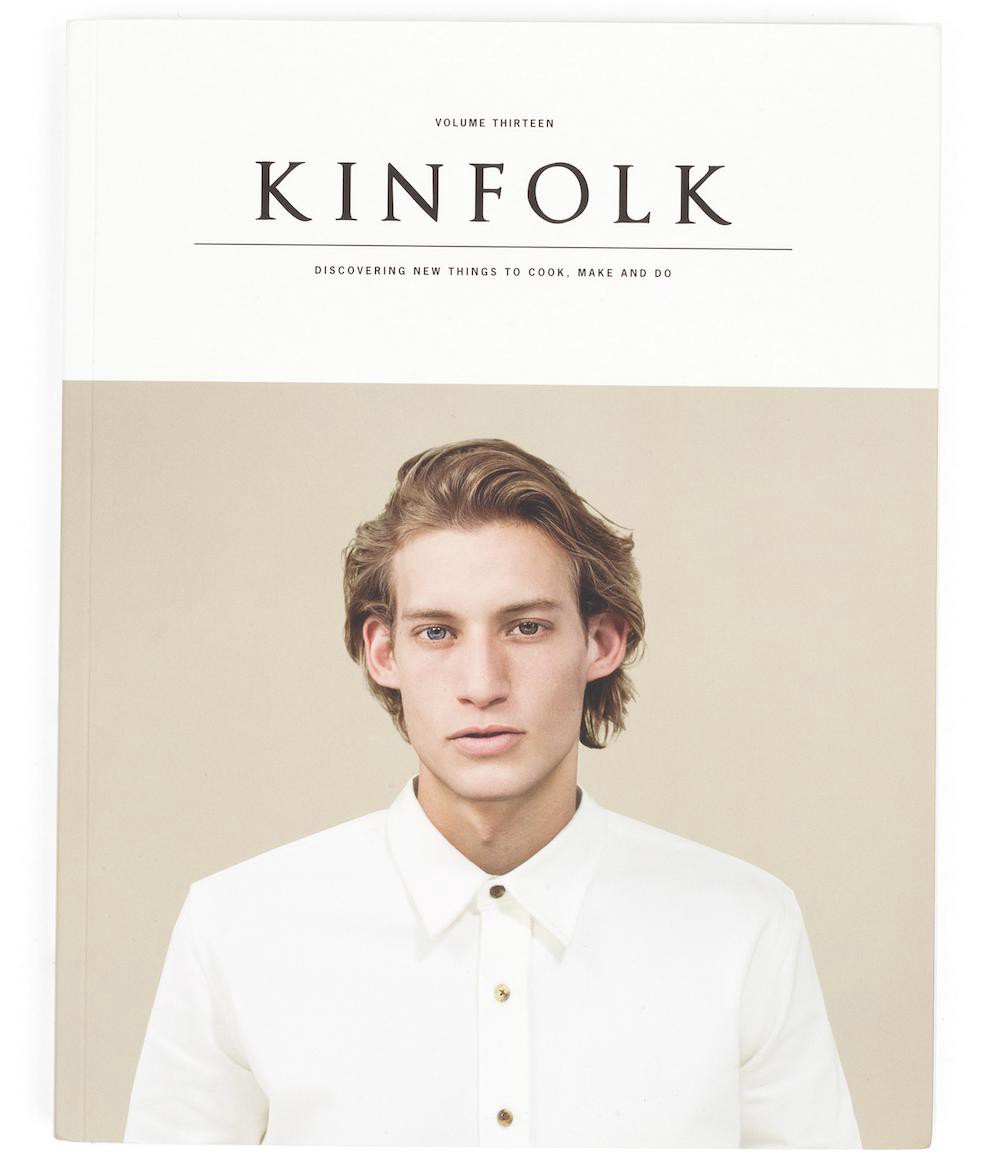
Whether the section’s promotion of consumer culture is defensible is a forest-for-the-trees sort of question. Harvard American Studies professor Lizabeth Cohen points out that the postwar development of a mass consumer economy was the result of a shared effort, one in which media participated, to convey “the message that mass consumption was not a personal indulgence” but a “civic responsibility” and a “critical part of a prosperity-producing cycle.” The New York Times was certainly complicit in that project. In September, 1945, the New York Times Magazine published an essay by AFL-CIO vice president Walter Reuther which bore the headline “Reuther Challenges ‘Our Fear of Abundance.’” Reuther wrote that the “central flaw of our economy” lay in a failure to “sustain mass purchasing power.” Failing to meet the expanded production capacities of reconverted war industries could, he warned, create “a situation potentially as explosive and damaging as the atomic bomb.” This idea is still strong today; echoes can be found in George Bush’s exhortation to go vacationing and shopping after 9/11. But certainly the paper helped produce the culture of conspicuous consumption that it now showcases in Styles and sustains in those sections we consider more noble. Why is anyone surprised?
Styles participates in producing and exposing public narratives about wealth and power with far more transparency and a more critical gaze than any other section of the paper does. (Maybe that’s not saying much!) One narrative that has emerged over the last decade is that luxury culture, broadly defined, is becoming more accessible to people with less wealth, and it’s made it into the Styles section precisely because it’s a story pushed by brands.
After Estée Lauder chairman Leonard Lauder revived the truism that the cosmetics industry is recession-proof and actually suggested that the “lipstick index” could indicate economic fluctuations in 2001, writers in the business section and the magazine, including pop economist Adam Davidson, simply repeated it and attributed it vaguely to economists. (So did Maureen Dowd, but in pure Dowd fashion.) Only in the Styles section did reporters ask economists about it and look at some numbers, much less correctly attribute the concept’s revival to Lauder. Also, they noted that it had “been largely discredited.”
Likewise, only the Styles section has taken so-called fast fashion seriously as a cultural and social — rather than solely economic — phenomenon. In the past decade, reporters have profiled purveyors of “cheap chic” like Forever 21 and the growth of celebrity and designer clothing lines at H&M; and Zara, treating them not merely as evidence of the recession, but as part of the evolving cultural narrative about the recession. (To be fair, Cintra Wilson’s 2009 Critical Shopper piece about J.C. Penney was a tone-deaf misstep. Can’t win ’em all.) In the same month that featured a profile of retail chain Steve and Barry’s, another feature noted that while cost-of-living indicators in virtually every other category of the Consumer Price Index have risen since the late 1990s, the price of clothing has gone down. The Styles section is perhaps the only section of the paper that has really examined how our perceptions of the economic downturn have aligned with reality — the only place where we might begin to ask what cheaper designer jeans might have to do with our inability to productively channel, much less sustain, the anger of Occupy Wall Street.
That probably isn’t by design (sorry), but it’s important. In the pages of Styles, a sense of access to luxury undermines the reader’s perception of growing class stratification and awareness of the contraction and concentration of wealth. Styles tracks how easy it is for a Bright Young Thing (White Young Thing?) to compartmentalize all of this. Sure, rents in Brooklyn have soared 77% over the last decade while real median income has dropped nearly 5%, but life’s small pleasures are increasingly considered within reach of New Yorkers; along with over-the-top opulence, the section also reflects a kind of genteel hipster affluence. The same members of Intern Nation who invoke OWS are also the same trend story subjects who carry status tote bags, who wear discount vintage-style frames, who are secretly planning to buy a copy of Kinfolk, and who are drinking ever-better coffee. All of this is so uncomfortable not because it’s clearly contemptible, but because it’s familiar and accessible: that one can both be in Styles and hate Styles section is a peculiarly contemporary paradox.
The Styles section isn’t fabricating any narratives about consumerism. To dismiss these stories, either because of their supposed lack of substance or because they’re uncomfortably accurate, is sloppy, dangerous thinking. If we wonder why it seems like we’re only now waking up to the crisis of economic stratification in this country, the Styles section has an answer. Is a story about beards stupid? Probably! But it also documents economic elites adopting the styles of their opponents. Styles stories also capture how Occupy Wall Street’s ideals have been folded into — and disseminated by — fashion designers. In this sense, the Styles section is a mirror that reflects the complex interactions of culture and capital. That we are the very shoppers being criticized can burn.
HAS ANYONE EVER WRITTEN ANYTHING FOR YOU
Earlier this fall, two New York Times stories that exposed the paper’s clumsy handling of race in two very different contexts came in for (deservedly) harsh criticism. First, reporter John Eligon wrote in an August 25th obituary that Michael Brown Jr., the unarmed teenager killed by Ferguson, MO police officer Darren Wilson, was “no angel.” While Public Editor Margaret Sullivan concluded that the use of the phrase was “a blunder,” many critics pointed out that the newspaper has used the phrase in demonstrably troubling ways when writing about black subjects. In a piece published the same day, a profile of Wilson simply noted that he had a “troubled childhood.”
Less than a month later, television critic Alessandra Stanley opened a profile of television producer Shonda Rhimes with the line “When Shonda Rhimes writes her autobiography, it should be called How to Get Away With Being an Angry Black Woman.” In addition to deploying a racist trope and calling it an “arch, provocative” lede, she invoked another stereotype, writing that actress Viola Davis, the star of Rhimes’ new show, “How to Get Away With Murder,” was “less classically beautiful” than her lighter-skinned professional peers. (Well, the whole thing was riddled with problems.) Here, Sullivan pushed back harder, saying that “readers and commentators are correct to protest this story” and that it’s “troubling that with 20 critics” at the paper, “not one is black and only two are persons of color.”
Confused why @nytimes critic doesn’t know identity of CREATOR of show she’s reviewing. @petenowa did u know u were “an angry black woman”?
— shonda rhimes (@shondarhimes) September 19, 2014
Like the vast majority of Times stories that have been the objects of scathing public scrutiny in the past months, neither was published in the Styles section. This is not to claim that the Styles section handles race more carefully or deftly than do other sections of the paper — but there isn’t a lot to suggest otherwise, either. The section has done a few pretty solid pieces about black hair and gender as part of the regular “Skin Deep” beauty feature. (That’s just one example. The section has also included stories about African American atheists, a profile of Kevin Liles during his years as an executive vice president at Warner, and black fans in the indie rock scene. Exploring how the Styles section — much less the Times — handles race is an adjacent but distinct project, to be sure, but I have yet to see a Styles story where a reporter uses a slur. I also suspect the section probably needs more writers and editors of color just as much as other departments do.)
What these stories do highlight is how little serious criticism has been directed at the Styles section in recent months, while major lapses appear elsewhere in the paper. Jack Shafer most recently took the paper to task for its use of unnamed sources; Styles didn’t come up. The section’s not popping up on Gawker’s radar very much, with a couple of exceptions concerning the paper’s anxiety about outing public figures, but neither describes a problem endemic only to the Styles section. (It may be one that suggests that homophobia still shapes newsroom dictums, though.) Even Marissa Meltzer’s rather infamous story about the Mellons, clothiers who have a “deep affinity” for Africa, which was a Styles story, seems in line with the self-aware sociological reporting that Charlotte Curtis pioneered. Nor have the paper’s Public Editors taken the section to task over the last several years. (Well, Margaret Sullivan managed to land this perfect zinger.) While the section is routinely vilified by name, the most serious ethical concerns leveled at the New York Times are almost never raised by reporting that has appeared in the pages of Styles.
THE OTHER NEWS
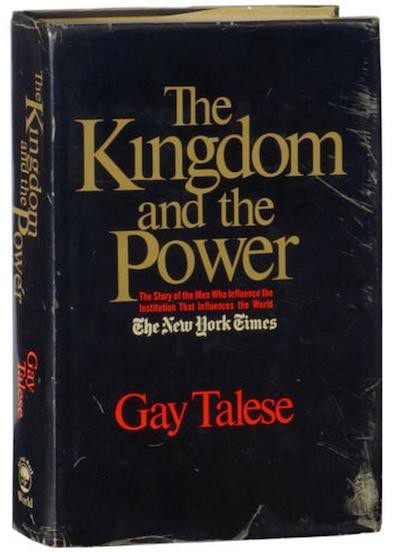
The conception of “women’s news” as an anchor for advertising and the contempt for the women’s pages were pretty naked expressions of contempt for women themselves, both as readers and writers (and sometimes even as consumers). Some of the brightest minds and sharpest talents at the paper were overlooked for decades and, in many ways, are still not part of the Times’ received history. Read Gay Talese’s exhaustive, iconic tome The Kingdom and the Power, published in 1969, and you’d be forgiven for thinking that there just weren’t any women there. (The first edition promised as much on the cover: “The Story of the Men Who Influence the Institution that Influences the World.”) Charlotte Curtis appears only briefly, and it’s clear that we’re not supposed to think much of her — that her success at the paper is merely the result of finding favor with Clifton Daniel, who protects her. Talese reports that editor Theodore Bernstein “and other critics” think “the women’s page gets too much space” and Curtis’s stories are too long; he quotes a letter that reporter David Halberstam wrote to a friend, in which Halberstam describes Curtis, by this time an editor, as “one of the most powerful men on the paper.”
These waves of anxiety, disgust and derision over the possibility that the section might publish “too many” stories that might be of interest to gay audiences are similarly motivated. Why is it so laughable that, first, the newspaper might have a gay readership (and of course it does!) and, second, that sometimes culture and style reporters might court this audience with content relevant to their lives — particularly while covering industries and geographies with strong contingents of, especially, gay men? Why would we assume that straight people don’t want to read about gay people? Why do we assume that this content, too, is really just a pretext for selling more advertisements? We can leave aside questions over whether that content only trades in stereotypes and whether it’s even possible to define a singular gay readership in this moment, because these really aren’t the concerns at hand. It’s not the case that critics of the Styles section charge that the paper is insulting its gay readers. It’s that the paper is pandering to them. And while we’re fortunately beyond the point of questioning the abilities and assumed biases of gay and lesbian reporters, the Times was for decades no easier on them than it was on women staffers.
Far from detailing the paper’s ignominious decline into muddy ethical waters and vacuous intellectual territory, the history of style reporting at the New York Times actually exposes some of the nastiest truths about misogyny and homophobia in the mass media: their intensity, their unbelievable durations (by which I mean “totally believable”), their active contemporary manifestations, and the role audiences play in perpetuating them. (Margaret Sullivan has even suggested that, while conditions appear to have improved for women at the paper–maybe — there are still questions about how women are treated in the paper.) We all can and should ask questions about how the newspaper’s editors and reporters assign coverage and come to the subjects that preoccupy them — but, frankly, we haven’t spent nearly enough time questioning the prerogatives of the rest of the paper. The upset that Styles engenders is difficult to parse, but easy to act out.
Or maybe it isn’t so difficult. For decades, many of us have used “reading the New York Times” as a kind of performance, a shorthand to convey our seriousness or sophistication or social cachet, or yes, even our affluence. To read the Times daily, we think, is to signify that one is in this world, but not of it. We imagine ourselves the world’s observers, its makers, or even its collective conscience. We want to believe we are reading from far above the fray of Juicy Couture, or Botox, or any of a hundred other manifestations of rank consumerism, vanity and anxiety. The section instead is a jarring, insistent reminder of the folly of this fantasy. Styles, we are you.
